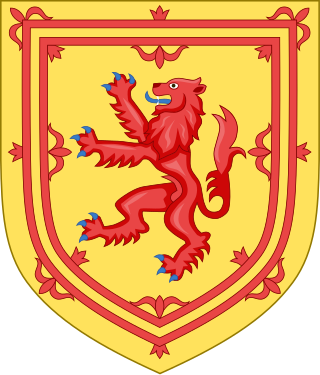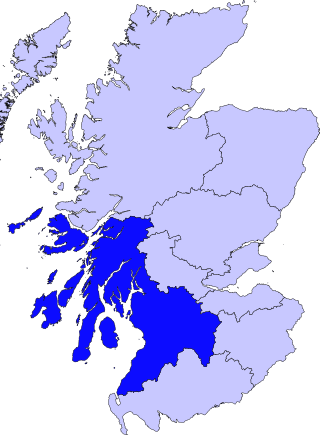Related Research Articles

Lanarkshire, also called the County of Lanark, is a historic county, lieutenancy area and registration county in the Central Lowlands of Scotland. The county is no longer used for local government purposes, but gives its name to the two modern council areas of North Lanarkshire and South Lanarkshire.

Local government in Scotland comprises thirty-two local authorities, commonly referred to as councils. Each council provides public services, including education, social care, waste management, libraries and planning. Councils receive the majority of their funding from the Scottish Government, but operate independently and are accountable to their local electorates. Councils raise additional income via the Council Tax, a locally variable domestic property tax, and Business rates, a non-domestic property tax.

Strathclyde was one of nine former local government regions of Scotland created in 1975 by the Local Government (Scotland) Act 1973 and abolished in 1996 by the Local Government etc. (Scotland) Act 1994. The Strathclyde region had 19 districts. The region was named after the medieval Kingdom of Strathclyde but covered a broader geographic area than its namesake.

The Local Government etc. (Scotland) Act 1994 is an Act of the Parliament of the United Kingdom which created the current local government structure of 32 unitary authorities covering the whole of Scotland.

Greater Glasgow is an urban settlement in Scotland consisting of all localities which are physically attached to the city of Glasgow, forming with it a single contiguous urban area. It does not relate to municipal government boundaries and its territorial extent is defined by the General Register Office for Scotland, which determines settlements in Scotland for census and statistical purposes. Greater Glasgow had a population of 1,199,629 at the time of the 2001 UK Census making it the largest urban area in Scotland and the fifth-largest in the United Kingdom. However, the population estimate for the Greater Glasgow 'settlement' in mid-2016 was 985,290 – the reduced figure explained by the removal of the Motherwell & Wishaw (124,790), Coatbridge & Airdrie (91,020) and Hamilton (83,730) settlement areas east of the city due to small gaps between the populated postcodes. The 'new towns' of Cumbernauld and East Kilbride (75,120) were never included in these figures despite their close ties to Glasgow due to having a clear geographical separation from the city. In the 2020 figures, the Greater Glasgow population had risen to just over 1 million.

The Central Belt of Scotland is the area of highest population density within Scotland. Depending on the definition used, it has a population of between 2.4 and 4.2 million, including Greater Glasgow, Ayrshire, Falkirk, Edinburgh, Lothian and Fife.

The Convention of Scottish Local Authorities (COSLA) is the national association of Scottish councils and acts as an employers' association for its 32 member authorities.

NHS Scotland, sometimes styled NHSScotland, is the publicly funded healthcare system in Scotland and one of the four systems that make up the National Health Service in the United Kingdom. It operates 14 territorial NHS boards across Scotland, 7 special non-geographic health boards, and NHS Health Scotland.
Community Health Partnerships, known as CHPs were subdivisions of Health Boards in Scotland, from 2005 to 2015, after which their functions were fully taken over by Health and Social Care Partnerships in April 2015.

NHS Ayrshire and Arran is one of the fourteen regions of NHS Scotland. It was formed on 1 April 2004.

Cornerstone, formerly known as Cornerstone Community Care, is a Scottish charity and social enterprise that provides support and care to children, adults and older adults living a range of long-term conditions and challenges. These include autism, learning and physical disabilities, dementia and mental health problems. It was founded in 1980 in Aberdeen and, since obtaining charitable status in 1981[1], Cornerstone has grown to become one of the largest charities in Scotland[2].
NHS Highland is one of the fourteen regions of NHS Scotland. Geographically, it is the largest Health Board, covering an area of 32,500 km2 (12,500 sq mi) from Kintyre in the south-west to Caithness in the north-east, serving a population of 320,000 people. In 2016–17 it had an operating budget of £780 million. It provides prehospital care, primary and secondary care services.
Healthcare in Scotland is mainly provided by Scotland's public health service, NHS Scotland. It provides healthcare to all permanent residents free at the point of need and paid for from general taxation. Health is a matter that is devolved, and considerable differences have developed between the public healthcare systems in the countries of the United Kingdom, collectively the National Health Service (NHS). Though the public system dominates healthcare provision, private healthcare and a wide variety of alternative and complementary treatments are available for those willing and able to pay.

The following is an alphabetical list of articles related to the United Kingdom.
This is a list of listed buildings in Scotland. The list is split out by council area.
The Better Care Fund is a partnership between NHS England, the Ministry of Housing, Communities and Local Government, the Department of Health and Social Care and the Local Government Association. Its pooled budget, initially £5.3 billion, was announced by the Cameron Government in the June 2013 Spending Round. It aims at "meeting the challenges of integrating health and social care in England in order to keep people healthy for longer". Local councils are allowed to increase the local fund. The intention was to shift resources into social care and community services from the NHS budget in England and so save £1 billion a year by keeping patients out of hospital. The pooled budget includes the Disabled Facilities Grants.
References
- ↑ "HSCPs | HSCScotland". hscscotland.scot. Retrieved 3 January 2023.
- ↑ "Health and social care integration". www.gov.scot. Retrieved 3 January 2023.
- ↑ "Integration of Health and Social Care". Convention of Scottish Local Authorities (COSLA). Retrieved 12 July 2015.
- ↑ Bradford, Eleanor (1 April 2015). "New laws streamline care in Scotland". BBC News .
- ↑ White, Linda (27 May 2015). "Readiness Towards Implementation". integration and reshaping blog. Scottish Government.
- ↑ Torrance, David (12 January 2012). "Scotland leading way in integration". The Guardian . Retrieved 12 July 2015.
- ↑ "Health and social care delivery plan". www.gov.scot. Retrieved 3 January 2023.
- ↑ "Foreword". www.gov.scot. Retrieved 3 January 2023.
- ↑ "Health and social care integration: update on progress". Audit Scotland. Retrieved 3 January 2023.
- ↑ "Health and Social Care integration: progress review". www.gov.scot. Retrieved 3 January 2023.
- ↑ "Health and Social Care integration: progress review". www.gov.scot. Retrieved 3 January 2023.